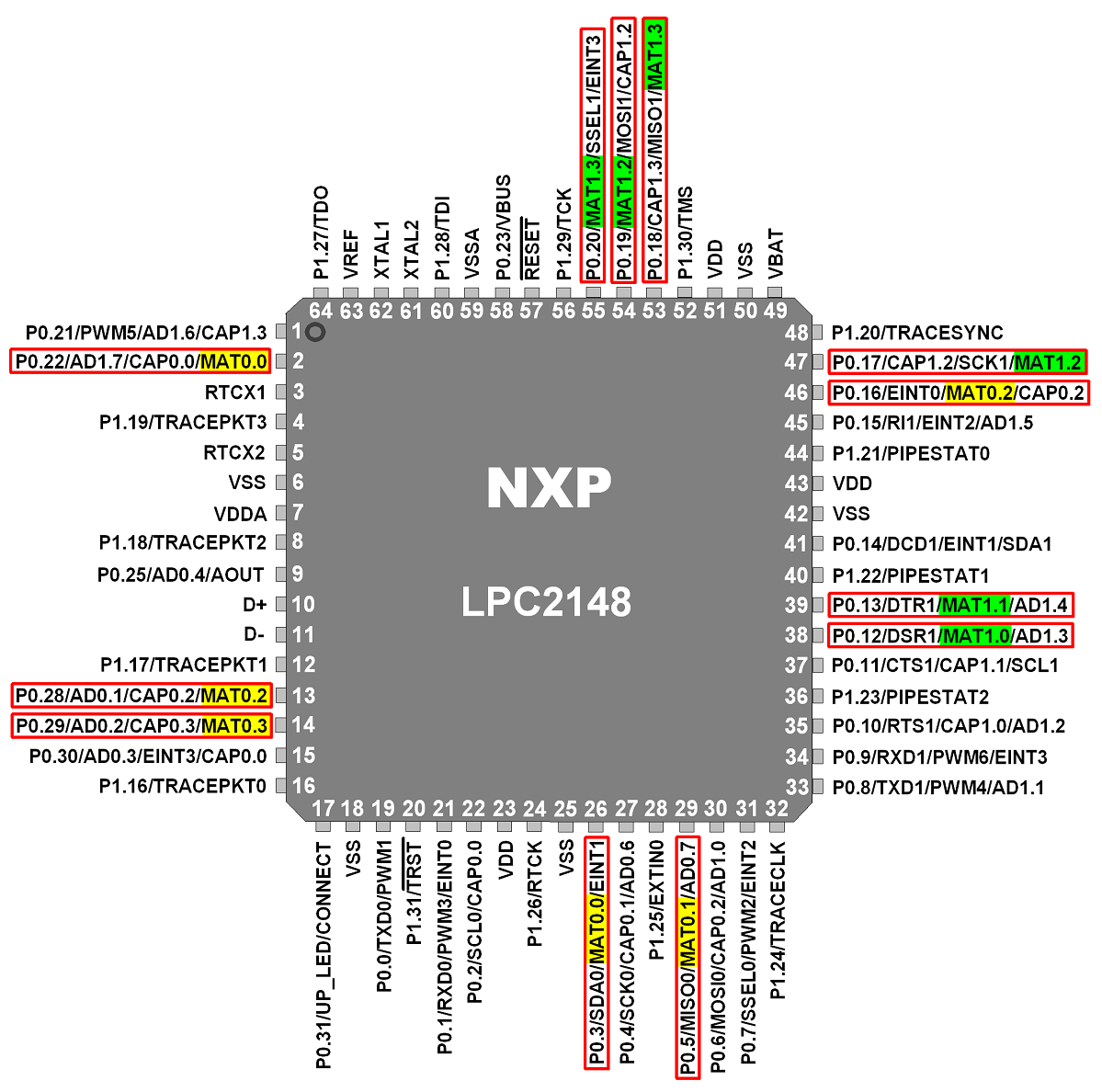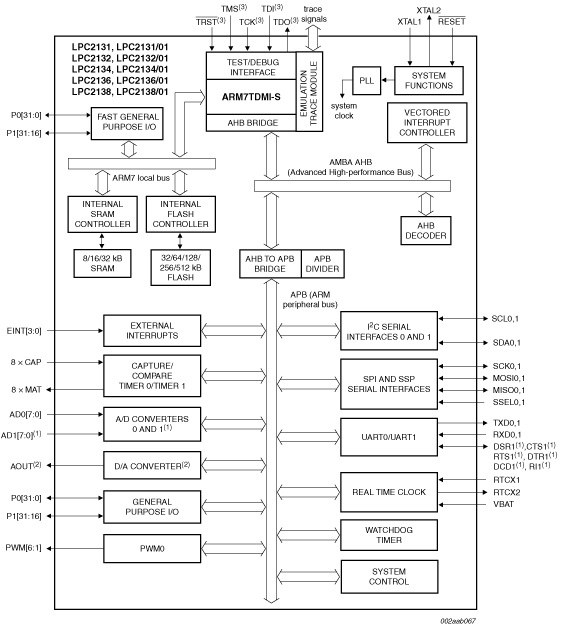Welcome to the ARM-LPC2148 repository! This repository contains a comprehensive collection of ARM-based program codes and materials for the LPC2148 microcontroller. The LPC2148, powered by the ARM7TDMI-S architecture, is an exceptional microcontroller that serves as a robust foundation for a wide spectrum of embedded applications.
-
Processor Core: The LPC2148 integrates the ARM7TDMI-S core, a powerful 32-bit RISC processor. It operates at clock frequencies up to 60 MHz, offering a balance of performance and efficiency for diverse computing tasks.
-
Memory: Boasting up to 512 KB of on-chip Flash memory, the LPC2148 provides ample space for program code storage. This microcontroller also includes 32 KB of on-chip RAM for data storage and manipulation, facilitating responsive and dynamic applications.
-
Clock Generation: Employing a flexible Phase-Locked Loop (PLL) system, the LPC2148 can synthesize precise clock frequencies. This capability is vital for synchronizing operations, interfacing with peripherals, and achieving desired performance levels.
-
Timers: The LPC2148 is equipped with versatile timers/counters. It features two 32-bit timers, which can be configured for various tasks such as precise timing, interval measurement, event counting, and generating periodic interrupts. Additionally, a watchdog timer enhances system reliability.
-
Serial Communication: With two UARTs (Universal Asynchronous Receiver-Transmitters), the LPC2148 simplifies asynchronous serial communication. These UARTs enable seamless interaction with external devices, facilitating data exchange in a multitude of applications.
-
Analog-to-Digital Conversion (ADC): The LPC2148 boasts two 10-bit ADCs with the capability to handle up to 14 analog input channels. This facilitates the accurate conversion of analog signals, making it indispensable for applications involving sensor interfacing and data acquisition.
-
General-Purpose I/O (GPIO): Featuring a substantial number of GPIO pins, the LPC2148 empowers developers to interface with external components like LEDs, switches, and displays. These pins can be configured as inputs or outputs, granting versatility in hardware design.
-
Communication Interfaces: The LPC2148 supports a range of communication interfaces including I2C (Inter-Integrated Circuit) and SPI (Serial Peripheral Interface). These interfaces enable seamless interaction with a variety of peripherals, fostering efficient data exchange.
-
Interrupt Handling: Efficient interrupt handling is facilitated by the Vectored Interrupt Controller (VIC). This mechanism permits prioritization and streamlined management of interrupt requests from different sources, optimizing responsiveness.
-
In-System Programming (ISP) and In-Application Programming (IAP): The LPC2148 features on-chip programming capabilities, allowing firmware updates through ISP and IAP. This flexibility reduces the need for external programming tools and simplifies the development lifecycle.
-
Low-Power Modes: With multiple low-power modes, the LPC2148 enables developers to tailor power consumption according to application requirements. This is particularly advantageous for battery-powered devices, enhancing energy efficiency.
The LPC2148 excels in a multitude of domains, including but not limited to:
- Embedded Systems: From industrial automation to consumer electronics, the LPC2148 serves as a core element in a wide range of embedded applications.
- Communication Protocols: The LPC2148's UART, I2C, and SPI capabilities facilitate seamless communication with peripherals and external devices.
- Human-Machine Interfaces: Leveraging GPIO, LCDs, LEDs, and switches, developers can create intuitive user interfaces for interactive systems.
- Sensor Networks and Data Acquisition: The ADC and communication interfaces empower the LPC2148 to excel in sensor-rich environments, acquiring and processing data efficiently.
- Motor Control and Actuation: Through PWM-driven outputs, the LPC2148 can precisely control motors and actuators in applications ranging from robotics to industrial control.
- Data Logging and Storage: With external memory interfacing capabilities, the LPC2148 can facilitate data logging onto storage devices such as SD cards.
- USB Connectivity and Networking: The LPC2148's USB 2.0 Full Speed Device Controller enhances connectivity options, while communication interfaces support networking capabilities.
- Microcontroller Education and Training: The LPC2148's approachable architecture makes it an ideal platform for learning about microcontroller programming and hardware interaction.
The following image provides a visual representation of the LPC2148 pin configuration:
For programming and flashing firmware onto the LPC2148 microcontroller, popular options include:
- USB ISP Programmers: These programmers connect to the microcontroller via USB, enabling convenient in-system programming (ISP). Examples include FlashMagic and LPC-Link2.
- JTAG Programmers: JTAG-based programmers offer debugging capabilities along with programming. The SEGGER J-Link is a widely used JTAG programmer compatible with LPC2148.
The data flow within the LPC2148 microcontroller involves various components working together harmoniously:
- Processor Core: The ARM7TDMI-S core executes instructions and manages operations.
- Memory Units: Flash memory stores program code, while RAM holds data during runtime.
- Peripherals: UARTs, ADCs, timers, and communication interfaces handle specific tasks.
- GPIO: General-Purpose I/O pins interface with external components.
- Interrupts and VIC: The Vectored Interrupt Controller manages and prioritizes interrupts.
Here is an illustrative diagram showcasing the key components of the ARM7TDMI-S architecture:
An illustration depicting the data flow model within the LPC2148 microcontroller:
Welcome to the ARM-LPC2148 repository! This repository contains a collection of ARM-based program codes and materials for the LPC2148 microcontroller. The programs are designed to run on the ARM7TDMI-S processor and are intended for educational and practical purposes.
- All LED Flash: A program to flash all LEDs on the board simultaneously.
- Simple LED Chasing: Code that creates a simple LED chasing effect.
- LED SW Interface: Program for interfacing LEDs with switches for interactive control.
- Timer Delay: Implementation of delay using timers for precise timing.
- Expt1a_LCD_Interface: Interface code for LCD display experiments.
- Expt1b_GLCD_Interface: Interface code for graphical LCD (GLCD) experiments.
- Expt2a_UART0_Serial_Comm: Code for UART communication using UART0.
- Expt2b_GSM_to_send_SMS_UART0: Code for sending SMS using GSM module via UART0.
- Expt2b_GSM_to_send_SMS_UART1: Code for sending SMS using GSM module via UART1.
- Expt2c_GPS_Interface_UART1: Code for interfacing GPS module via UART1.
- Expt2d_GSM_Interface: Code for GSM module interfacing.
- Expt3a_ADC_polling_method: Code for ADC interfacing using polling method.
- Expt3b_ADC_Interrupt_method: Code for ADC interfacing using interrupt method.
- Expt4_SD_Card_Interface: Code for interfacing SD card.
- Expt5a_I2C_EEPROM_n_LCD: Code for I2C EEPROM and LCD interfacing.
- Expt5b_I2C_EEPROM_n_UART: Code for I2C EEPROM and UART interfacing.
- TFT_8bit_Interface_ILI9325: Code for 8-bit TFT LCD interface (ILI9325).
- TFT_16bit_Interface_SSD1289: Code for 16-bit TFT LCD interface (SSD1289).
- Collection of ARM assembly programs for LPC2148 microcontroller.
To use a program from this repository:
- Open or create a new project in your preferred Integrated Development Environment (IDE) for ARM7 microcontrollers.
- Add the main program file (e.g.,
main.c) to your project. - Include necessary header files for the program's functionality.
- If your program depends on other files (e.g.,
lcd.coruart.c), include them in your project. - Compile the project to generate the executable.
Before using any program, kindly read through the provided files and documentation to understand the functionality and usage.
Contributions to this repository are welcome! If you find any issues or want to add more programs, feel free to create a pull request or report the issue.
If you have any questions or need assistance, you can reach out to naikdp1212@gmail.com.
Happy coding with ARM-LPC2148!


